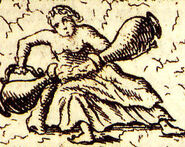Assessment |
Biopsychology |
Comparative |
Cognitive |
Developmental |
Language |
Individual differences |
Personality |
Philosophy |
Social |
Methods |
Statistics |
Clinical |
Educational |
Industrial |
Professional items |
World psychology |
Personality: Self concept · Personality testing · Theories · Mind-body problem
In some Christian traditions, there are four cardinal virtues: prudence, temperance, fortitude, and justice. These were derived initially from Plato's scheme (see Protagoras 330b, which also includes piety (hosiotes)) and adapted by Saint Ambrose, Augustine of Hippo, and Thomas Aquinas (see Summa Theologica II(I).61).
The term "cardinal" comes from the Latin cardo or hinge; the cardinal virtues are so called because they are pivotal to any life of virtue.
Cardinal virtues in the Bamberg Cathedral
Plato identified them with the classes of the city described in the Republic, and with the faculties of man. Temperance was associated with the producing classes, the farmers and craftsmen, and with the animal appetites; fortitude with the warrior class and with the spirited element in man; prudence with the rulers and with reason. Justice stands outside the class system and divisions of man, and rules the proper relationship among the three of them.
It may have been taken up from there into Jewish philosophy; Wisdom 8:7 reads, "She [Wisdom] teacheth temperance, and prudence, and justice, and fortitude, which are such things as men can have nothing more profitable in life."
It was certainly taken up in Christianity, as St. Augustine, discussing the morals of the church, described them:
For these four virtues (would that all felt their influence in their minds as they have their names in their mouths!), I should have no hesitation in defining them: that temperance is love giving itself entirely to that which is loved; fortitude is love readily bearing all things for the sake of the loved object; justice is love serving only the loved object, and therefore ruling rightly; prudence is love distinguishing with sagacity between what hinders it and what helps it.
These "cardinal" virtues are not the same as the three theological virtues: faith, hope, and charity (see 1 Corinthians 13). Together, they comprise what is known as the seven cardinal virtues, also known as the heavenly virtues.
History of the Virtues[]
While history suggests that the first four date back to Greek philosophers and were applicable to all people seeking to live moral lives, the theological virtues appear to be specific to Christians as written by Paul in The New Testament.
In Genesis, Chapter 28 Jacob describes his vision of a ladder or stairway leading to heaven. In oral tradition, the three principal rungs on the ladder were denominated Faith, Hope and Love. (The King James Version of the Bible uses "charity," but "charity" was derived from caritas, or "love.") These three are mentioned in Chapter 13 of First Corinthians: And now these three remain: faith, hope and love. But the greatest of these is love. Because of this reference, the seven attributes are sometimes grouped as four cardinal virtues (prudence, temperance, fortitude, justice) and three heavenly graces (faith, hope, charity).
The cardinal virtues are distinguished from the capital virtues. The capital virtues are often paired with the much more widely known capital (or "deadly") sins. The capital virtues are: humility, liberality, brotherly love, meekness, chastity, temperance, and diligence. The capital sins, sometimes called the "seven deadly sins," are pride, avarice (greed), envy, wrath, lust, gluttony, and sloth.
References[]
- St. Ambrose, "On the Duties of the Clergy" Book 1, chapter 24 (paragraph 115) and following
- St. Augustine, "Of the Morals of the Catholic Church"
External links[]
- Catholic Encyclopedia "Cardinal Virtues"
- Seven Virtues (atheism.com)
- Cardinal Virtues according to Aquinas (New Advent)
| This page uses Creative Commons Licensed content from Wikipedia (view authors). |



